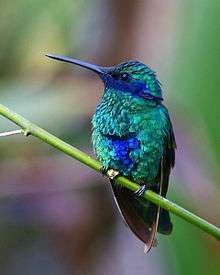Sparkling violetear
| Sparkling violetear | |
|---|---|
 | |
| Scientific classification | |
| Kingdom: | Animalia |
| Phylum: | Chordata |
| Class: | Aves |
| Order: | Apodiformes |
| Family: | Trochilidae |
| Genus: | Colibri |
| Species: | C. coruscans |
| Binomial name | |
| Colibri coruscans (Gould, 1846) | |
The sparkling violetear (Colibri coruscans) is a species of hummingbird. It is widespread in highlands of northern and western South America, including a large part of the Andes (from Argentina and northwards), the Venezuelan Coastal Range and the Tepuis. It occurs in a wide range of semi-open habitats, even in gardens and parks within major cities such as Quito, and is often the commonest species of hummingbird in its range. The sparkling violetear is most abundant near coniferous or evergreen eucalyptus forests. It is highly vocal and territorial.

The sparkling violetear is the largest violetear at 13 to 15 cm (5–6 in) long. Male birds weigh 7.7 to 8.5 grams (0.27 to 0.3 oz) while females weigh from ounces 6.7 to 7.5 grams (0.24 to 0.26 oz). This hummingbird resembles the lesser violetear, but that species generally prefers more humid habitats, is obviously smaller and lacks the distinct purple-blue chest-spot and chin of the sparkling violetear. According to [2] it has the smallest mean blood-air barrier thickness (0.183 µm) and the highest mass-specific respiratory surface area in birds (87 cm²/g).
Sparkling violetears are solitary and aggressive. Birds declare their territory by singing. The birds sing much of the day, and (in different parts of their range) sub-groups develop their own calls. Breeding seasons vary by region. Birds in Venezuela mate from July through October. Birds find mates at leks, areas where groups of males try to attract a female to mate. After mating, the male was once believed to leave all nesting responsibilities to the female. However, according to reports, male sparkling violet-ears were seen twice caring for their young. The mother lays two eggs in a tiny, cup-shaped nest made of twigs and other plant material. Eggs hatch in 17 to 18 days. The young fledge in three weeks.
References
- ↑ BirdLife International (2012). "Colibri coruscans". IUCN Red List of Threatened Species. Version 2013.2. International Union for Conservation of Nature. Retrieved 26 November 2013.
- ↑ Dubach, M. (1981), "Quantitative analysis of the respiratory system of the house sparrow, budgerigar and violet-eared hummingbird", Respir Physiol, 46 (1): 43–60, doi:10.1016/0034-5687(81)90067-0, PMID 7330491
